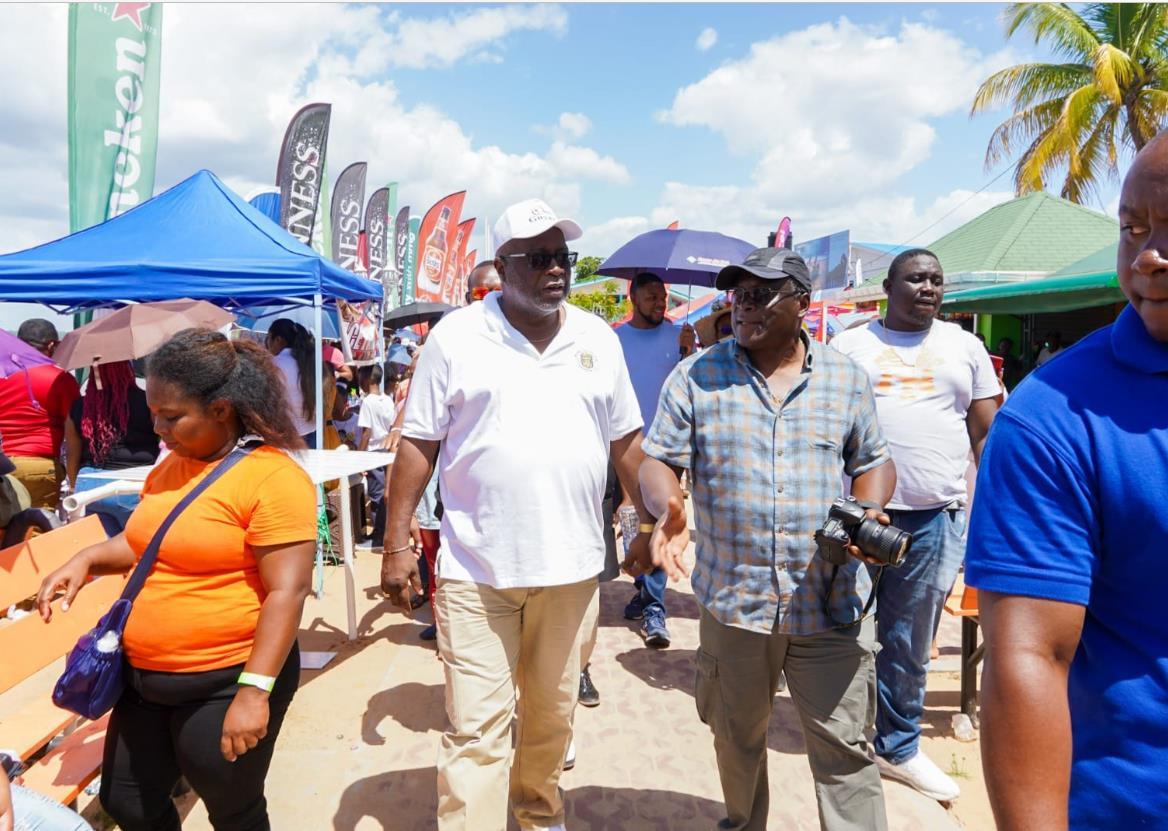Quotes of the President of Guyana
1. Happy Birthday to my stressbuster. I pray you continue to be the loving, caring, and concerned boy you are.
2. I have instructed the Ministerof Parliamentary Affairs and Governance and the Attorney General thatthe NationalIntelligence and Security Agency (NISA)Billbe sentto aSpecialSelectCommittee of the Parliamentso that the views and ideas of all stakeholders can be examined.
3. I urge all of us to engage in a renewal of thinking. A renewal of purpose and a renewal of commitmenttowards our country and towards each other. Investmentand money cannotbring aboutthat renewal. Thatrenewalmustcome through a personalcommitment. Through personal change to advance back betterinterpersonalbehaviours.
4. People-centred development is crucial for our country. Mind my words, not party-centred development, people-centred development. That is what the People’s Progressive Party/Civic is about;people-centred development,puttingpeopleatthe front, puttingpeople atthe centreand workingfrom behind to advance those at the centre and those at the front.
5. Our message is a singular message; not designed by geographic locations or circumstances, not designed by audience, by political opportunism, designed with interestof people atthe centre of the message and plans. We will deliverprosperity to every home and every Guyanese.

6. I have instructed the Ministerof Parliamentary Affairs and Governance and the Attorney General thatthe NationalIntelligence and Security Agency (NISA)Billbe sentto aSpecialSelectCommittee of the Parliamentso that the views and ideas of all stakeholders can be examined.
7. Policing is not isolated from development and developmentis not isolated from policing…The security architecture of a country is a bedrock through which development, sustainability, resilience, and progress can be achieved.
8. The agency was created years ago. I came as the Presidentand metNISA; theNationalIntelligence Agency was there before my presidency. This NationalIntelligence and Security Agency has been operatingfor a numberof years;overa decade.
1823-2023. Bicentennialof the Demeraraslave rebellion
14
9. Now, this Bill seeks to remove that cloak of apparent secrecy, and to bring a transparent legal structure into being, and to establish an accountable framework in respect of the agency itself, and those who will man and comprise the agency, and to say clearly how the agency will be funded. Once it is funded from public funds, its audited accounts are going to be laid in the National Assembly, and shall now become subjectto parliamentary oversight.
10. The reportof the Commission of Inquiry would make a strong point that people who hold public office mustrealise that public office is a sacred office and not a personaloffice. And whateverthe political view in the performance of theirpublic duty, they mustadhere to rules and regulations
Harry Belafonte is dead

“On March 1, 1927, a couple from the Caribbean island of Jamaica - Harold George Bellanfanti (born in Martinique, grew up in Jamaica) and Melvine Bellanfanti(born and raised in Jamaica) - gave birth to a son at a hospital in Harlem, New York.
The child's name was Harold George BellanfantiJr.” Today, we know this gentleman as HARRY BELAFONTE!
The child grew up in New York, USA with his parents and in Jamaica ���� with his grandmother.
At the age of 17, he decided to leave his High School training and education behind, and joined the United States Navy. There, he served fornearly 2 years;it was duringthe time of the Second World War.
Afterleavingthe United States military, Belafonte found work as a janitor; nothingmuch else in terms of work was available foryoungAfrican-Americans in the post-warAmerica.
During this period, a woman gave him a free ticket and he attended a theatrical performance at the American Negro Theater in Harlem. It was there that he met and became friends with another young aspiring artist, from the Caribbean, (Bahamas) - Sidney Poitier. They became lifelongfriends.
Both of them were aspiring but, nevertheless strugglingactors! They both found the going tough with hardly enough money to sustain themselves!
Belafonte was given an opportunity to sing in clubs! This extra income was used to supplement his theater income, and any extras was used to pay for acting classes. There he met the likes of Marlon
1823-2023. Bicentennialof the Demeraraslave rebellion
15
Brando, Lucille Ball and Walter Matthau, all youngentertainers with huge dreams and aspiring to make a name for themselves in entertainment.
Belafonte began singing with Charlie Parker's band, which included Charlie "Bird" Parker (saxophone, bandleader), Max Roach (drums), and Miles Davis (trumpet).
By the late 1940s-early 1950s, Harry Belafonte along with recording and acting, evolved into a Civil Rights activist and became a major supporter of singer-actor-activist Paul Robeson and scholar-activist W.E.B Dubois.
In 1950, Dr. W.E.B. DuBois, the first African-American to earn a Doctor of Philosophy degree from Harvard University, was a member of the National Council of Arts, Sciences and Professions, a socialist anti-war organization. He was also the leader of the Peace Information Center, an anti-war and antinuclear organization.
DuBois, like Robeson, became a major target for the McCarthyists and was indicted by the federal governmentforallegedly beingan agentof the SovietUnion.

At the time, Harry Belafonte was a young 24-year old struggling actor who found himself picketing outside the New York court building where DuBois was being arraigned. At that time, he was virtually unknown in the acting and activist world.

Belafonte, who later befriended Civil Rights leader and activist, Rev. Martin Luther King, would one day become a well known singer, actor and activist. His songs, Day-O -The Banana Boat song and Jamaican Farewell as well as a Christmas classic, “Mary’s Boy child,” all seared Belafonte as an unforgettable figure and voice in American and Internationalconsciousness! May this Legend Rest in Peace! Having lived for 96 impactful years, may a new generation of people come to appreciate the indelible mark leftby Harry Belafonte on our collective consciousness!
Thank You! R.I.P. #officialdetroithistorian
16
1823-2023. Bicentennialof the Demeraraslave rebellion
Harry Belafonte and Miriam Makeba
Birth anniversaries




17
1823-2023. Bicentennialof the Demeraraslave rebellion
Elder Eusi Kwayana b.4 April
Hon. Roysdale Forde b.21 April
Lois MillicentLambert b.23 April 2023 H.E. PresidentIrfaan Ali b.25 April
Message the GIHR Face book page

1823-2023. Bicentennialof the Demeraraslave rebellion

18
SlingshotDrepaul b.26 April
GIHR Catalogue
Request a
Dr. Mark Kirton posted on his face book page, “A few day ago . In adherenceto a legal legal requirement, I presented copies of my new book to thethree repositories - the University of Guyana Library , theNational Library and theNationalArchives .




I was disappointed to learn that , to a large extent, this requirement is not fulfilled by local authors and editors .
I thereforeappealto my fellow authors to enhancethenationalcollection and to givethosewho may not be in a position to acquire personal copies , the access to your work and promote reading and critical thinking.”
19
1823-2023. Bicentennialof the Demeraraslave rebellion
Mark Kirton
Kester Hutson
GeorgetownChamberof Commerce gets new President
By News Source Guyana on March 30, 2023
The other members of the executive are Richard Rambarran of NCB Capital Markets (Guyana) Incorporated. He will serve as the new SeniorVice President, while Gavin Ramsoondarhas taken overthe postof Junior Vice President.
Georgetown Chamberof Commerce gets new President
Director of Dapper Technologies Incorporated, Kester Hutson has been elected as the new President of the Georgetown Chamber of Commerce and Industry (GCCI). He previously served as a Junior Vice Presidentof the country’s oldestbusiness chamber.

Hutson has replaced businessman, Timothy Tucker. The organisation recently held its annual general meeting, where the elections were held.
The other members of the executive are Richard Rambarran of NCB Capital Markets (Guyana) Incorporated. He will serve as the new SeniorVice President, while Gavin Ramsoondarhas taken overthe postof Junior Vice President.
GTT’s Orson Ferguson is the new treasurerof GCCI while Kathy Smith has been elected Secretary. Ministerwithin the Ministry of Public Works, and formerPresidentof the GCCI, DeodatIndar, in his virtual address, urged the members of the umbrella organization to better position themselves as the country continues to experience unprecedented growth.
He said the Construction, Housing, Education, Agriculture and Health Sectors have major opportunities for investments.
“In the Housing Sector, a lot of houses are being built, a lot of blocks is needed, zinc is needed, pipe is needed, all kind of fittings is needed, bathroom stuff, tiles, you name it, is needed in the sector, workers is needed. So, because of the growth, the demand for all these things will go up, naturally, it has to be supplied, and thatputs members of the chamberin aposition that they can go afterthese opportunities,” he said.
However, he warned thatin branching outinto other sectors, there are risks that mustbe assessed.
1823-2023. Bicentennialof the Demeraraslave rebellion
20
Minister Indar also assured the GCCI members that with the coming of the Gas-to-Energy Project, businesses will be able to enjoy a reliable supply of electricity at extremely low cost. He noted too that the signature projectwill also presenta lot of business opportunities.
GCCI’s OutgoingPresident, TimothyTucker, in presentinghis reportfortheperiod 2022-2023, said despite facing numerous challenges, the Chamber persevered and offered tremendous opportunities for networkingand economicadvancement amongmembers.
“In 2022, the net surplus decreased to G$4.3M from the previous year’s surplus of G$7.4M. However, revenue increased to G$90.6M from G$78M in 2021. The expenses forthe year were G$86.4M, up from G$70.6M in 2021. What’s even more noteworthy is the cash and cash equivalent, which amounted to G$56.7M at the end of the year, compared to G$50.9M. This indicates that the company has a healthy cash flow and is well-positioned to investin future growth opportunities,”MrTuckersaid. He said while the netsurplus may have decreased, the increase in revenue and cash reserves bodes well for the Chamber’s financial health and future prospects.
The former President of the GCCI also said the organisation has played an important role in advocating for Local Content Legislation with a focus on the Oil and Gas Sector, and will continue to push for 40 addition services to be added to the existinglist of services in the schedule underthe Local ContentAct.
The greatest literary hoax in history
By Ralph Ramkarran
April 23, 2023
William Shakespeare
459 years ago today, William Shakspere was born in Stratfordupon-Avon, England. He died there 407 years ago today, in 1616, at the age of 52. There are no documentary records that link William Shakspere to William Shakespeare, the dramatist and poet, and greatest writer in the English language. In 1920 J. Thomas Looney in “Shakespeare Identified,” raised the authorship question which had emerged long before. He identified Edward de Vere, the 17th Earlof Oxford, as the writer who used the pseudonym “William Shakespeare.” Among the famous doubters that William Shakspere was the dramatist William Shakespeare are: Harry Blackmun (19081999) US Supreme Court Associate Justice; Charlie Chaplin (1899-1977) actor/comedian; Ralph Waldo Emerson (18031882) poet;Sigmund Freud (1856-1939) psychotherapist, John Galsworthy (1863-1933) Nobel prizewinning novelist; Sir John Gielgud (1904-2000) Shakespearian actor and director; Henry James (1843-1916) novelist; Lord Palmerston (1784-1865) British Statesman; Lewis Powell (1907-1998) US Supreme Court Associate Justice; Mark Twain (1835-1910) American writer; Walt Whitman (18191892) American poet;Charles Dickens (1812-1870) British novelist;SirMark Ryland (1960- ) Shakespearian actor.
I encountered the subject several decades ago and was impressed by the arguments. A few years later, 100 Shakespearian scholars issued aletterclaiming, withoutevidence, thatWilliam Shakspere was indeed William Shakespeare.I was duly deflated, butcontinued to harbourdoubts. Allthe while asignificantbody of opinion grew, supporting the view that there is an authorship question. After some hesitation, I re -

21
1823-2023. Bicentennialof the Demeraraslave rebellion
engaged with the subject and now, on Shakspere’s birth and death anniversaries, I have summoned up the courage to defy the 100 scholars – experts in Shakespeare’s works,butnotnecessarily in Shakspere’s life. I rely on the numerous scholars and writers who have devoted decades to examining the evidence and who have pronounced in favourof there beingan authorship question. Shakspere allegedly attended a grammar school in Stratford-upon-Avon as a child. No records of the schoolsurvive, so Shakspere’s attendanceis assumed.The plays and poetry of William Shakespeare reveal him to be a man of great scholarship, well read, highly educated, knowledgeable in several languages, familiar with games and pastimes of the nobility and theirnorms, behaviourand attitudes,had knowledge of Italy where severalplays are based. Yet William Shakspere neverattended university, leftno evidence of education ortraining, had no known access to alibrary orbooks, had no means of knowingany language otherthan English, had no known contact with the nobility and neverleftEngland. What are the chances of a genius who has written at least 37 plays, 2 long poems and 154 sonnets, leaving no manuscripts, books, letters, notes, writing, or evidence of contact with other writers and no document except a will and 6 shaky signatures, which reveal a person who is clearly uncomfortable with using a quill? This is not sufficient evidence to prove conclusively that William Shakspere was illiterate, as was his father and 70 percentof Elizabethan men, butit certainly begs the question. The 60 documents about Shakspere that have been discovered have been used by Donna Price in “Shakespeare’s UnorthodoxBiography”to outline his documentary life. Amongthe highlights are:ablank for the years 1585-1591; loans granted by him and legal action to recover others; payment for performances in 1595; a persistent tax delinquent; legal actions against him; purchase of New Place in Stratford-upon-Avon in 1598 and 100 acres in 1602; fined for hoarding grain in 1598; a creator of King’s Men, a Royal acting company; his father’s will instructing his executorto recover a loan of 40 shillings to the wife of “Wyllyam Shaxpere”(differentspellings of both names were common);investmentin tithes; and purchase of a house nearBlackfriars. Shakspere’s documentedactivities revealhim to be an investor, businessman, moneylender, trader, actor, a convicted hoarderand tax cheat. The documentary record contains no evidence that Shakspere was a poet and playwright or that he was recognized as a writer during his lifetime, as was all well-known writers at that time and for whom documentary evidence is available today. He was not recognized by anyone in Stratford-upon-Avon as a writer. There was no commentabouthis disappearance from the literary scene in London afterhe retired to Stratford-upon-Avon in 1611 at the heightof his alleged powers. His passingin 1616 wentunnoticed in literary circles. No writer commemorated the passing of one of the greatest dramatists of the day, as usually occurred. Was Shakspere, the illegal grain hoarder and tax cheat, whose wife borrowed money from herfather-in-law and did not repay, who bequeathed herhis second-bestbed and whosedaughters were illiterate, also the literary genius, who wrote the greatestworks in the English language?
If Edward de Vere used the pseudonym of “William Shakespeare,”there was good reason. Atthattime, it was an unthinkable violation of convention fora nobleman to publish poetry or plays forperformance. It was not until the 1623, in a foreword in the First Folio of Shakespeare’s plays, that Ben Jonson, Shakespeare’s bestknown contemporary, who allegedly knew thatShakspere was notShakespeare, used the vague and ambiguous designation, “sweetswan of Avon,”to describe Shakespeare, thereby confusing him with Shakspere. Thus began the greatestliterary hoax in history.
(This column is reproduced with permission from Ralph Ramkarran’s blog, www.conversationstree.gy)
1823-2023. Bicentennialof the Demeraraslave rebellion
22
GIHR Call for papers and abstracts for the Sixteenth Conference Theme: Race relations, cultures and, politics
Abstracts and proposals will be accepted by 9 June 2023.
Hosted by the GuyanaInstitute of Historical Research
The GuyanaInstitute of Historical Research is pleased to call for papers and abstracts for its 16th Annual Conference.

For the 2023 conference, the committee willconsiderproposals on all aspects of Race relations, cultures and, politics, especially encouragingsubmissions thatreflecton this year’s theme;submissions thatfocus on other topics will also be entertained by the Committee. Submissions of pre-organized panels and roundtables are strongly encouraged.
1823-2023. Bicentennialof the Demeraraslave rebellion
23
During the TWO days Conference, each panel will have 3-4 presenters (each 20-15 min., respectively), possibility of submission of a partial session with at least2 presenters.
Panel, roundtable, and pictorial proposals will include the following information: followingcriteria:
Proposal explains the topic, research questions, methodologies, and historiographic significance in ways that specialists and non-specialists alike can understand. (10 points)
Proposalpresents new findings orrevisions of long-held interpretations. (10points) Panelproposals must include a panel title and 300-word abstract summarizing the theme of the panel; paper title and a 300word abstract for each paper proposed; and a one-page professional curriculum vitae for each panelist (including the chair and commentator).
Roundtable proposals mustinclude a roundtable title, a 300-word abstract summarizing the roundtable’s themes and points of discussion, and a one-page curriculum vitae for each participant (including the moderator, if any).
Individual paper proposals are also welcome and must include a paper title, 300-word abstract of the paper, and one-page vita with contact information and email address. If accepted, individual papers will be assigned by the program committee to an appropriate panel with a chair and commentator.
Volunteers, who wish to serve as chairs and commentators should send a one-page curriculum vitae to one of the followingpersons:
GIHRConference specialist Syndrene Harris –syndrene.harris @uog.gy.com
Registrar Hazel Woolford –gihrinstitut@gmail.com
Proposals will be judged according to the Proposaladdresses the conference theme. (5points)
Participants may presentone paper, serve on aroundtable, orprovide panelcomments. They may notfill more than one of these roles during the conference, with the following exception:Members who act as panel chairs may delivera paper, serve on a roundtable, or offercomments in anothersession. You may invite persons through the print or social media to be members of your panel. Members who serve as both the chairand commentatorof asingle session may notpresentin anothersession. If members attach themselves to more than one proposal in violation of the above rules, then the first proposal that arrives will be considered by the program committee and any subsequent proposals that include that member will be rejected.
All the correspondence, otherthan related to paperabstracts submission and acceptance, should be sent by e-mail for the Conference Organizing Committee, to the attention of the GIHR Conference specialist Syndrene Harris - syndrene.harris @uog.gy.com
The Organizing Committee would appreciate your familiarizing the members of your research/teaching unit, as well as all interested colleagues, with the presentAnnouncement.
1823-2023. Bicentennialof the Demeraraslave rebellion
24
Panels
1. Memorializinganeventin history .
a. 1763 Berbice revolution.
b. 1823 Demerara rebellion.
c. 1853. The arrival of the Chinese in BritishGuiana.
d. 1913 Rose Hall labour protest.
e. 1953 The suspensionof the Waddingtonconstitution.
2. The Diasporas: Historical and Contemporary
a. Twice deceived.
b. Illegal immigration.
c. Little Guyana.


d. The Caribbeannationals and colonials and the British government.
e. Kamla Harris, Jamaica and Modi.
3. Africans and the human condition.
a. Contributions of Africans to the Foundingof Civilizations
1823-2023. Bicentennialof the Demeraraslave rebellion
25
Tours
Venue for the GIHR Welcome reception and the Plenary sessions
b. The trans-Saharan slave trade.
c. Slave trade, slavery and manumissionin Africa, Europe and the Americas.
d. Africans, apartheidand South Africa.
e. Migrants and Expatriates
f. Africans in India.
g. Afro-Futurism
4. Christianityand Indian immigration
a. The Presbyterianchurch.
b. Berbice HighSchool.
c. The Lutheran church.
d. Christianschool teacher inthe class room, practicing Hindupriest at home.
e. The plantation ownerand the religionof labourers.
5. Gender, women, race and, identity
a. The feminizationof the University.
b. Gender, womenand, small business.
c. Genderbasedviolence inthe plantationsociety.
d. People trafficking.
6. Libraries, special collections, and historical bibliographies.
a. The Academicteaching library.
7. Main trends in education
a. Education policy.
b. Teaching Caribbeanhistory in a plural society.
c. Adult educationand learning.
d. Future learning.
e. Politics and education.
f. Ethnic studies.
g. Caribbeanstudies.
h. Private schools
8. Business and ethnicity.
a. Plantation economyand businesses.
b. Portuguese and businesses.
c. YesuPersaud.
d. The tea plantations and the Irish.
e. Industrialization.
f. Historyof the oil industry in Guyana.
g. Food and nutrition security.
h. Parallel economy.
i. Cash transfers .
j. Socio economictransformation in Guyana and the Caribbean.
k. Guyana National Cooperative Bank.
9. Politics, trade unions and, Indians.
a. Jung Bahadur Singh
b. Jainarine Singh
c. MohammedAyube Edun
d. Cheddi Jagan
e. J.P. Latchmansingh.
10. Architecture
a. Gender, womenand prisons.
1823-2023. Bicentennialof the Demeraraslave rebellion
26
b. Architecture and school buildings inthe developingworld.
c. Architecture and the construction of hospitals.
d. The GeorgetownPublicHospital.
11. Pandemics in the colonies
a. The medical history in the colonies
b. Cholera
c. Malaria
d. Yellowfever
e. The influenzaepidemic.
f. Ebola.
g. Covid
h. Monkeypox/small pox.
12. Culture and the Arts.
a. Indian art and artists
b. Doris Rogers
c. PhillipMoore
d. Monuments and public art.
e. Spirituality.
f. The writings of WalterRodney.
g. The creole world of Guyana and the Caribbean.
h. The Guyana prize.
13. International Relations.
a. The world economicorder.
b. Globalization.
c. Non AlignedMovement.
d. The Problemof Territorial Settlements.
e. The Commonwealthof nations and the former members of the British empire.
1823-2023. Bicentennialof the Demeraraslave rebellion
27
REGISTRATION FORM.
Sixteenth Conference of the Guyana Institute of Historical Research
Venue of the Openingceremonyand plenary sessions:CritchlowLabour College
WoolfordAvenue
Georgetown
Dr. [] Mr. [ ] Mrs. [ ] Ms. [ ] Prof. [ ]
Name:
Address
Telephone Number: (Home ) ____________________________(Office) ____________________________(Cell)
E-mail: ____________________________________
Organisation:___________ ____________________
Educator [ ] Postgraduate student[ ] Researcher[] Administrator[]
Please submita copy of yourconference presentation in the week of the conference, as well as a video presentation/powerpoint for the conference secretariatto share. If unable to do so, please setup your presentation.
Please fill outthis form or a photocopy
Contact person:Ms. Syndrene Harris- syndrene.harris @uog.gy.com
Download, scan and return Registration form to gihrinstitut@gmail.com/gihrinstitute@yahoo.com
1823-2023. Bicentennialof the Demeraraslave rebellion
28
The history of Essequibo Coast
 By RajkumarSingh
By RajkumarSingh
"Essequibo was founded by colonists from the first Zealander's colony, Pomeroon, which had been destroyed by Spaniards and local warriors around 1596. Led by Joost van der Hooge, the Zealander's travelled to Kyk-Over-Al. This location was chosen because of its strategiclocation and the trade with the local population. Van derHooge encounteredan olderruined Portuguese fortthere (thePortuguesearms had been hewn into the rock above the gate). Using funds of the West Indian Company, van der Hooge built a new fort called "Fort Ter Hoogen" from 1616 to 1621, though the fort quickly became known amongst the inhabitants as Fort Kyk-Over-Al (English: Fort See-everywhere). The administration of the WestIndian Company as wellas the governorof the entire colony settled here in 1621. Initially, the colony was named NovaZeelandia(NewZeeland), butthe usageof the name Essequibosoon became common. On the southern shore of the river the hamlet Cartabo was built, containing 12 to 15 houses. Around the river, plantations were created where slaves cultivated cotton, indigo and cacao. Somewhatfurtherdownstream, on Forteiland or"GreatFlag Island", Fort Zeelandiawas built. From 1624 the area was permanently inhabited and from 1632, together with Pomeroon, it was put under the jurisdiction of the Zeelandic Chamber of the WIC (West Indian Company). In 1657 the region was transferred by the Chamber to the cities of Middelburg, Veere and Vlissingen, who established the "Direction of the New Colony on Isekepe"there. From then on Pomeroon was called 'NovaZeelandia'. In 1658, cartographer Cornelis Goliath created a map of the colony and made plans to build a city there called "New Middelburg", but the Second Anglo-Dutch War (1665 – 67) put an end to these plans. Essequibo was occupied by the British in 1665 (along with all other Dutch colonies in the Guianas), and then plundered by the French. The followingyears the Zeelanders sentasquardron of ships to retake the area. While the Suriname colony was captured from the British by Abraham Crijnssen, the by then
1823-2023. Bicentennialof the Demeraraslave rebellion
29
abandoned Essequibo was occupied by Matthys Bergenaar. In 1670 the Chamber of the WIC in Zeeland took over control of the colonies again. The Dutch colonies in the region endured much suffering as a result of the Nine Years' War (1688 – 97) and the Spanish Succession War (1701 – 14), which brought pirates into the region. In 1689 Pomeroon was destroyed by French pirates, and abandoned.
The Chamberof the WIC in Zeeland keptcontroloverthe colonies, which sometimes led to criticism from The Chamber of the WIC in Amsterdam, who also wanted to start plantation there. The Zeelanders however, had established the colony by themselves, and afterthey retook possession of Essequibo under command of the commanderof FortNassau Bergen in 1666, they considered themselves as rightfulrulers of the region. Under governor Laurens Storm van 's Gravesande, English planters started coming to the colony after1740.
After 1745, the number of plantations along the Demerara and her side-rivers rapidly increased. Particularly, British colonists from Barbados began settling here. After 1750 a commander of the British population was assigned, giving them their own representation. Around 1780 a small central settlement was established at the mouth of the Demerara, which received the name Stabroek in 1784, named after one of the directors of the West Indian Company. From 27 February 1781 to February 1782 the colony was occupied by the French. In 1796 it was permanently occupied by the British. In 1800, Essequibo and Demeraracollectively held around 380 sugercane plantations. At the Peace of Amiens, the Netherlands received the Essequibo colony for a short time, from 1802 to 1803, but after that the British again occupied it. In 1812 Stabroek was renamed by the British as Georgetown. Essequibo became officialBritish territory on 13August1814 as partof the Treaty of London, and was merged with the colony of Demerara. On 21 July 1831, Demerara-Essequibo was united with Berbice to create British Guiana, now Guyana.
In 1838, Essequibo was made one of the three counties of Guiana, the other two being Berbice and Demerara. In 1958, the county was abolished when Guiana was subdivided into districts. Currently, historical Essequibo is part of a numberof Guyanese administrative regions and the name is preserved in the regions of Essequibo Islands-WestDemeraraand UpperTakutu-UpperEssequibo."
[Source:GuyanaSpeaks]
1823-2023. Bicentennialof the Demeraraslave rebellion
30
Mayor presents citationsto Guyanese cultural icons

Out-going Georgetown Mayor Pt. Ubraj Narine recently honoured citizens with the Citation Award for their significant contribution to culture, youth, art, entertainment, leadership, and education.
Narine, speaking with Village Voice News said he was delighted to show his appreciation of the diverse individuals for theircontributions to the developmentof Guyana. The award eventwas held April 20. According to the mayor, the talents of the honoured individuals are not only evidence of Guyana’s diversity but also representative of the beauty thatflows from such diversity. We are one people, one nation and one destiny, he said, and that too is reflected in our diverse talents, ethnicities, politics, heritage and we must appreciate and celebrate these because we all belong to the human race and should be respected forwho we are.
Narine said Guyana must rid itself of the divisive politics and Government must seek to work with the Opposition, at the national, regional and local governmentlevels, forthe benefitof all Guyanese. People are tired of the hate, political division and poverty he shared. If Guyana could only practice the politics of inclusion no othercountry on earth would be betterthan us, he stated.
1823-2023. Bicentennialof the Demeraraslave rebellion
31
Nominations day- Local Government Elections


32
1823-2023. Bicentennialof the Demeraraslave rebellion
Elections (LGE) in Guyana.
Dharamlall sets June 12 for LGE
Minister of Local Government and Regional Development Nigel Dharamlall
Local Government and Regional Development Minister Nigel Dharamlall has set Monday, June 12, 2023, as the date for the holding of the much-anticipated and long overdue Local Government
This was announced on Thursday evening. Section 35 (1) of the Local Authorities (Elections) Act, Chapter 28:03 empowers the LocalGovernmentMinisterto appointa day for the elections.
Last week, the Chairperson of the GuyanaElections Commission(GECOM),Retired Justice ClaudetteSingh had written the Local GovernmentMinisteraskinghim to setMay 22 this yearforthe conductof the local polls.
But on Thursday, MinisterDharamlall responded to the GECOM Chairand indicated that the LGEwere set for June 12 instead.
LGE were initially set for March 13 this year, but GECOM had deferred it in December 2022 to address issues relating to its registration exercise. This postponement occurred after court action was filed by Opposition-aligned persons, challenging the process used to compile the List of Electors, or Voters’ List, forthe pendingLGE.
“This decision was taken at a special meetingof the Commission held on Thursday, 8th December, 2022 which was held to deliberate on a proposal submitted by the Chief Elections Officer (CEO), Mr Vishnu Persaud to conduct an Exercise to correct the Registers of Voters for Local Government Elections under Section 24A of the Local Authorities (Elections) Act, Chapter 28:03,” the Elections Commission had explained last December.
Only last week, the seven-member Elections Commission approved a new work plan produced by CEO Persaud that recommended May 22, 2023, as the earliest possible date for the holding of the local polls based on the Secretariat’s capacity.

33
1823-2023. Bicentennialof the Demeraraslave rebellion

34
1823-2023. Bicentennialof the Demeraraslave rebellion


35
1823-2023. Bicentennialof the Demeraraslave rebellion

36
1823-2023. Bicentennialof the Demeraraslave rebellion














































 By RajkumarSingh
By RajkumarSingh







